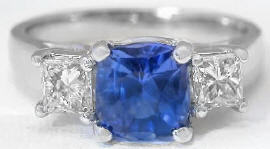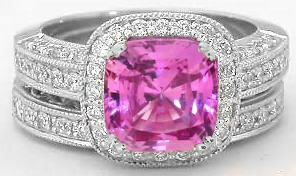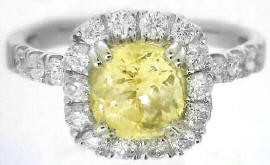


Our Selection of Sapphires:
We are very proud of the natural sapphires that we offer at MySapphireSource. Since we are a small company, and
since most of our sapphire rings are one of a kind and we maintain very high quality standards by hand picking each
stone for its exceptional color, clarity, cut, and overall appearance.
For each sapphire that we do select, we literally reject hundreds of stones
because they do not meet our higher quality standards. For example, as a general rule we reject sapphires that
have any visible inclusions, color zoning, poor color, large windows, and sapphires that are too deep or too
shallow. These lower quality stones are generally used by larger companies who need produce a larger volume
of rings.
So when you select a sapphire from MySapphireSource, you can be assured that
you are purchasing one of the finest sapphires available.
Sapphires come in every color of the rainbow and we strive to offer a range of colors. The most popular colors
of sapphire are blue, pink and yellow and within those colors, we offer a range of shades: from light to intense
cornflower, to cobalt and rich blue, from baby pink to hot pink or magenta, and from pale banana yellow to lemon
yellow or bright sunshine yellow. Color is such a personal choice and we want our customers to be able to
find the color that they are drawn to most.
back to top
Why Choose a Sapphire for an
Engagement or Promise Ring?
Sapphires are truly special, available in nearly any color and cut, and offer an wonderful opportunity to
create a unique, one of a kind engagement ring. Diamonds most often are much more expensive and not nearly as
impressive as a gorgeous sapphire with the wonderful color that you love.
The highest
quality and most desirable and beautiful colors of sapphire are available at MySapphireSource.
Our
gorgeous eye-catching ring designs are very unique and many are available only through our website. There's a
reason our tag line is 'Set Yourself Apart.'
Also, I bet you did not know that sapphires are more tough than diamonds and therefore more resistant to breaking and chipping! Read more under Durability below.
back to top
Durability
Most people have heard that diamonds are the hardest
gemstone and are harder than most things on the planet. Hardness is
defined in the jewelry industry as resistance to scratching. So that
means that almost nothing can scratch a diamond. And that is why a
diamond is generally recommended as the top choice for an engagement
ring stone.
But did you also know that while the hardness of a
diamond is excellent,
the toughness of diamonds is only fair to
good
? Toughness is defined as resistance to breaking, chipping
or cracking. In considering day to day wear and tear, this is a critical
consideration. If hit just right, a diamond can easily break or chip. So
that’s why we encourage consumers to consider various gemstones,
particularly sapphire, when selecting an important ring that will be
worn every day. Sapphires and rubies are the second hardest gemstone and
have a toughness level of excellent (better than the toughness of a
diamond).
Sapphires are much less prone to breaking or chipping
than a diamond
.
Sapphires are very durable and ideal for everyday wear, much like diamonds.
Gemstones are rated on their ability to withstand surface scratching using the Mohs Scale of Hardness. The
only gem rated harder, more stable and more durable than a sapphire is a diamond. A diamond, as the hardest
mineral known, receives a hardness rating of 10 and sapphires follow closely with a hardness rating of 9.
Sapphires also have excellent durability, which means they are difficult to break or chip. And sapphires are not
sensitive to heat, light, and chemicals.
back to top
Heat Treatment of Natural
Sapphires (Industry Accepted):
Approximately 99% of sapphires used in jewelry are heat treated. Heat
treatment is an industry accepted standard practice and is used to improve color, clarity, and overall appearance
of sapphires. This closely replicates natural process that may occur inside the Earth before a sapphire is mined.
The heat treatment process is permanent and the sapphires require no special care as a result of the heating.
The value of heated sapphires has increased over time in the same way that the value of
unheated sapphires has increased.
Since heat treatment is the
industry standard treatment of sapphires and is permanent, heat treatment does not require disclosure. There are
other treatments of sapphires, such as diffusion, which do require disclosure and do negatively affect the value
of the sapphires. We do not purchase any sapphires with these alternate types of treatment. While most
people select heated sapphires, MySapphireSource offers a beautiful selection of both heat treated and unheated
(i.e., untreated) sapphires in our jewelry.
Treatments that are Not Standard (not Industry Accepted):
There are several treatments that are not industry accepted and that do diminish the value of the sapphire.
These treatments include irradiation, filling, dying, introduction of beryllium, and of course, lab
creation. MySapphireSource does not sell any sapphires with these treatments.
Unheated Sapphires (untreated):
A very small percentage of sapphires that are mined are cut into a finished gem without undergoing man-induced
heat treatment. Unheated sapphires (also know as untreated sapphires) with exceptional clarity and color are very
rare and generally command a premium in price.
There is no visible difference in
the appearance of a heated versus an unheated sapphire
of the same color, cut and clarity. Customers
who want to own a sapphire that is even more rare and feel that the rarity justifies the additional cost select
unheated sapphires.
back to top
Certification and Grading:
Every sapphire that we purchase is also tested
in-house by our graduate gemologist to verify that it is a natural mined
sapphire. With each sapphire that our customers purchase at $699 and above,
we provide a Certificate of Authenticity,
so you can have additional assurance that you are receiving a natural sapphire.
The certificate, signed by our graduate gemologist, will be, in many
cases, accepted by your insurance company as proof of your sapphires
authenticity. An industry standardized grading scale for
sapphires (or colored stones in general) does not exist. Though there are several testing agencies that provide
detailed gem grading reports, they can vary quite a bit. We have adopted a
clarity grading scale using terms that are commonly used in the jewelry industry, and all of our sapphires are
given a clarity grade. Color is very subjective and plays an important factor in determining the quality and value
of the sapphire. An experienced gem cutter will carefully facet each gem to bring out and showcase its color,
clarity and brilliance in the best possible way. The faceting of gemstones is not fully standardized; therefore
making grading non-standardized as well.
back to top
|